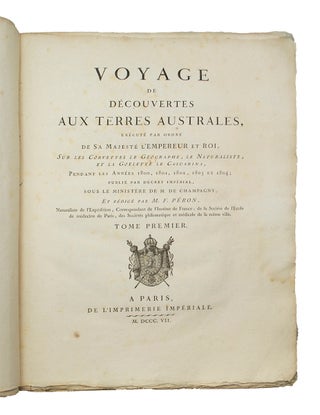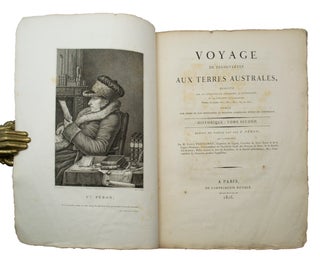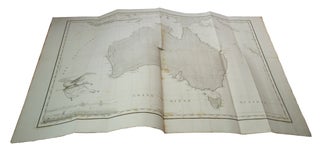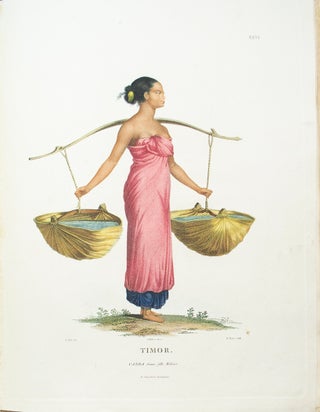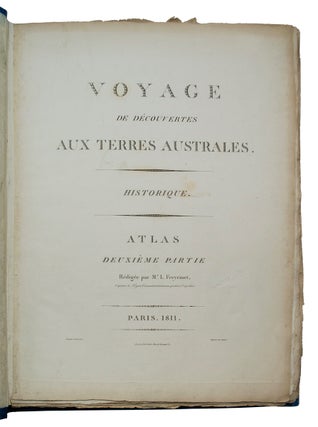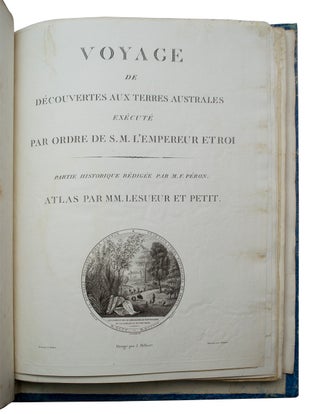Uncut in Original Wrappers
Voyage de découvertes aux Terres Australes. exécuté par ordre de Sa Majesté l'Empereur et Roi, sur les Corvettes "Le Géographe", "Le Naturaliste", et la Goëlette "Le Casuarina", pendant les années 1800, 1801, 1802, 1803 et 1804; publié par décret impérial, sous le ministère de M. de Champagny, et rédigé par M. F. Péron, Naturaliste de l'Expédition.
Paris: Imprimerie Impériale, 1807.
Louis FREYCINET. Voyage de découvertes aux Terres Australes, exécuté par ordre de Sa Majesté l'Empereur et Roi, sur les corvettes "Le Géographe", "Le Naturaliste", et la goëlette "Le Casuarina", pendant les années 1800, 1801, 1802, 1803 et 1804; publié par décret impérial, sous le ministère de M. de Champagny, et rédigé par M. F. Péron, Naturaliste de l'Expédition. Paris: Imprimerie Impériale, 1807-1816.
First edition. Complete with two text volumes ('Historique') and one atlas volume in two parts. Text: Quarto (12 x 9 1/4 inches; 306 x 235 mm). [4], xvi, 496, [2, errata], [8 publisher's ads]; xxxi, [1, blank], 471, [1, blank]. Uncut. Both half-titles present, engraved frontispiece portrait of Peron and two folding charts in second volume. Atlas: Quarto (14 x 11 inches; 353 x 275 mm.) Two parts bound together. First part with fourteen engraved maps and plans (of which two are folding), and the second part with forty plates numbered II to XLI and of which twenty-three are hand-colored and two are double page. With eight-page bookseller's catalog in first text volume. Entirely complete.
All volumes uniformly bound in original blue wrappers. Atlas with with wrappers over boards. With some restorations to spines. Printed paper labels, on spine of two text volumes, and on front board of atlas. Atlas with ties. Some dampstaining to beginning few pages of volume I and to pages 449-460 of volume II. Some occasional toning to signatures, but generally very clean. The large folding maps with some minor foxing, but overall the plates are clean and bright. Overall, a magnificent copy of one of the very most important books in the annals of natural history, cartography and Australian studies.
"In 1800 an expedition organized by the Institute of France and placed under the command of Nicholas Baudin sailed for the South Seas. Their particular instructions were to make a full and minute examination of the Australian coasts, and especially to explore the southern coast, 'where there is supposed to be a strait communicating with the Gulf of Carpentaria, and which consequently would divide New Holland into two large and almost equal islands." However, the exploration was a very lethargic affair under Baudin's command, seemingly spending most of the time "picking up shells and collecting butterflies." Peron complained bitterly of Baudin's conduct of the voyage, and in his account does not even so much as mention his commander's name. The maps and charts prepared by Freycinet, who continued the publication after the death of Peron,... depict the whole of the south coast, from what is now Melbourne to the border of Western Australia, as the "Terre Napoleon'" (Hill). Both England and France had colonies in the general area and would have viewed Australia as a fine base of operations. Mattthew Flinders was exploring this area at about the same time and many say that Freycinet's map os Australia was largely cribbed from Flinders' work. Nonethess, Freycinet's map of Australia is still considered to be one of the finest ever engraved. Before the second volume of Voyage... was completed, Péron took ill and died of tuberculosis in 1810. The directorship of the project was taken over by Louis de Freychinet, the map maker and surveyor who had been aboard the Naturaliste. The second volume was eventually published in 1816.
This voyage was particularly important for its contributions to natural history. "Péron was part of a large team and he had many jobs to do. His studies on the voyage included anatomy, anthropology, botany, zoology, meteorology, oceanography and naval hygiene. Péron took it upon himself to study the tiny soft marine creatures of the Australian waters. At King George Sound he collected some 1060 new species of seashells and a vast collection of starfish. Lesueur was always at the ready with brush and many of the images he captured remain deeply admired and treasured today. Encouraged by Péron, Lesueur draw a wide range of Australian animals in strict scientific pose and detail. These include emu from Kangaroo Island (believed to be an extinct species), platypus, fish and frogs. Many species of birds and animals were trapped and killed and put into specimen jars filled with alcohol to preserve them. At the end of the expedition Peron and Lesueur had collected what is considered to be most complete and best documented collection of marine natural history. Over one hundred thousand species of animals had been collected and stored in thirty three large packing cases aboard Le Naturaliste" (Australian Broadcasting Corporation).
Ferguson, Australia, 449. New Hill 1329. Sabin 60998. Brunet IV, 503 (Peron)
HBS 68425.
$25,000.
Price: $25,000.00
Item #68425


